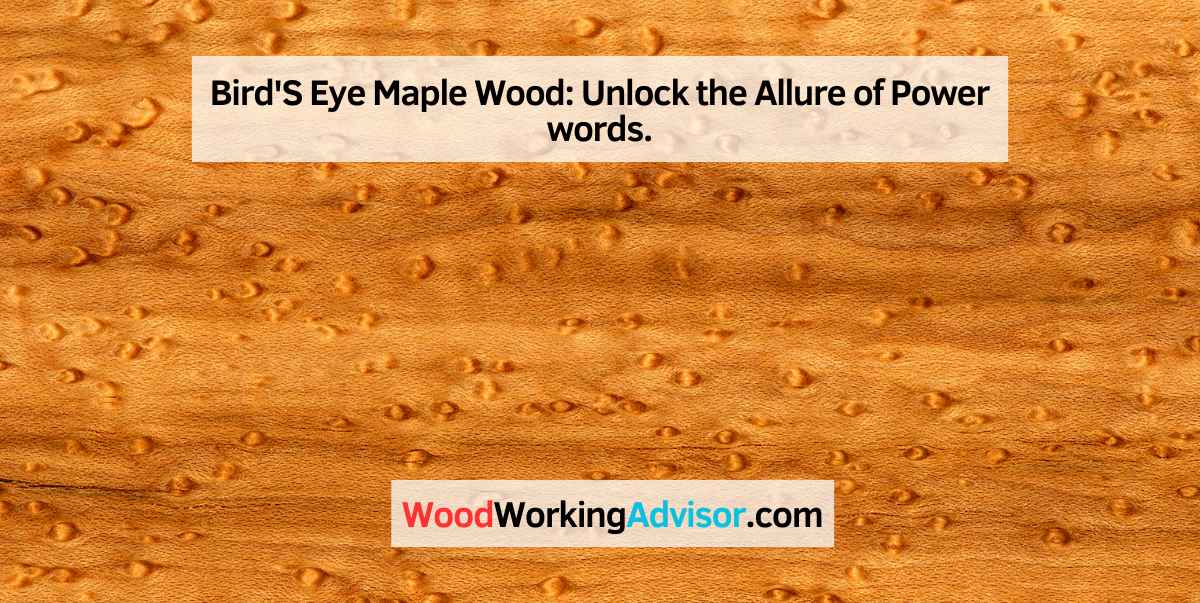Bird’s eye maple wood is a highly sought-after type of wood known for its unique, small “bird’s eye” patterns. This rare and distinctive wood is prized for its use in making high-end furniture, musical instruments, and decorative items.
Bird’s eye maple wood is characterized by its intricate and mesmerizing grain patterns, which resemble small bird’s eyes. This distinctive appearance makes it a popular choice for creating elegant and refined pieces. The wood’s exceptional natural beauty and durability have contributed to its desirability among craftsmen and designers.
Bird’s eye maple wood is often used in the creation of luxurious furniture, musical instruments such as guitars and violins, as well as decorative items like veneers and inlays. With its visually captivating patterns and sturdy nature, bird’s eye maple wood continues to be a favored choice for those seeking to add a touch of sophistication to their creations.

Credit: www.espn.com
Exploring Bird’s Eye Maple Wood
Discover the exquisite beauty of Bird’s Eye Maple wood, renowned for its unique grain pattern resembling small, swirling ‘bird’s eyes’. This rare and highly sought-after wood is favored for its intricate figuring and natural elegance, making it a prized choice for artisanal woodworking projects.
Origin And Characteristics
Bird’s Eye Maple Wood comes from various species of maple trees, particularly the sugar maple and the black maple. The unique and mesmerizing patterns in this wood are a result of an unexplainable phenomenon within the tree’s growth. The characteristics of this wood include a distinctive visual appeal, with intricate patterns resembling small “bird’s eyes”.
Unique Patterns And Colors
The patterns of bird’s eye maple wood feature intriguing circular formations, creating a visually stunning effect. The colors range from creamy white to a light reddish-brown hue, adding to its aesthetic charm.
Bird’s Eye Maple Wood exhibits unique natural patterns that make it an ideal choice for luxurious furniture and decorative items. The distinctive features of this wood, including its stunning patterns and colors, make it highly sought after in the woodworking industry.

Credit: www.gutenberg.org
History And Significance
Bird’s Eye Maple Wood has a rich history and holds significant cultural value. Its unique markings have made it a sought-after material for centuries, and its contributions to various industries are noteworthy. Explore the historical significance and cultural value of this exceptional wood.
Cultural Value
The Bird’s Eye Maple Wood holds immense cultural value, appreciated for its visually captivating patterns and exceptional quality. It has been revered by artisans, craftsmen, and designers for its distinctive appearance, making it a coveted choice for creating exquisite furniture, musical instruments, and decorative items.
Historical Significance
Bird’s Eye Maple Wood gained historical significance due to its usage in crafting fine furniture during the 19th and 20th centuries. Its popularity surged as it became a symbol of luxury and craftsmanship, adorning the interiors of opulent homes and prestigious establishments. The wood’s intricate patterns and durability have ensured its enduring appeal over centuries.
Utilization In Different Industries
Bird’s Eye Maple wood is highly valued for its unique grain pattern, making it a popular choice in various industries. From luxury furniture to musical instruments, its distinct appearance adds elegance and character to a range of products, making it a sought-after material for high-end craftsmanship.
Bird’s Eye Maple Wood is a versatile material that finds application in various industries. Let’s explore how this unique wood is utilized in different sectors.
Furniture Making
Bird’s Eye Maple Wood is a popular choice in creating exquisite and high-end furniture pieces. It enhances the aesthetic appeal of furniture due to its distinct grain pattern and texture.
Musical Instruments
This exceptional wood is highly sought after in the construction of musical instruments such as guitars and pianos. It contributes to the superior sound quality and visual appeal of these instruments.
Care And Maintenance Tips
Bird’s Eye Maple Wood is known for its stunning beauty and unique grain patterns, making it a popular choice for furniture and decorative items. To ensure that your Bird’s Eye Maple Wood pieces retain their beauty and last for years to come, it’s important to follow proper care and maintenance techniques. This section will provide you with essential tips to preserve and clean your Bird’s Eye Maple Wood effortlessly.
Preservation Techniques
Preserving the natural beauty of Bird’s Eye Maple Wood requires a few essential techniques. Here are some preservation tips to keep in mind:
- Avoid direct sunlight: Keep your Bird’s Eye Maple Wood furniture away from direct sunlight, as it can cause fading and discoloration over time.
- Control humidity levels: Maintain a consistent humidity level of around 40% to 45% to prevent the wood from warping or cracking. Use a humidifier or dehumidifier if necessary.
- Apply protective finish: Apply a high-quality protective finish, such as polyurethane or varnish, to create a barrier between the wood and potential damage. Make sure to follow the manufacturer’s instructions for application.
- Use coasters and trivets: To prevent water rings or heat damage, always use coasters and trivets under glasses, hot dishes, or other items that may leave marks on the wood surface.
Cleaning Methods
Regular cleaning is essential to maintain the beauty of your Bird’s Eye Maple Wood. Follow these care tips for effective cleaning:
- Dust regularly: To remove dust and dirt, use a soft microfiber cloth or a feather duster. Avoid abrasive materials that can scratch the surface of the wood.
- Wipe spills immediately: Accidents happen, so it’s important to wipe up any spills immediately using a damp cloth. Avoid using excessive water or harsh chemicals that can damage the wood.
- Gentle cleaning solution: For deeper cleaning, mix warm water with a mild dish soap or wood cleaner. Dampen a cloth or sponge in the solution, wring out any excess liquid, and gently clean the wood surface.
- Thoroughly dry: After cleaning, ensure the wood is completely dry to prevent any moisture from seeping into the grain. Use a clean, dry cloth to wipe away any remaining moisture.
Future Prospects And Trends
Bird’s Eye Maple Wood has a promising future ahead, with increasing demand and growing interest from both consumers and industry professionals. Let’s take a closer look at the sustainability practices and market demand that are driving the future prospects and trends of Bird’s Eye Maple Wood.
Sustainability Practices
One of the key factors shaping the future prospects of Bird’s Eye Maple Wood is its sustainable sourcing and production methods. Manufacturers and suppliers are increasingly adopting sustainable practices to preserve the ecological balance and ensure the longevity of this unique wood.
By prioritizing responsible forest management, Bird’s Eye Maple Wood manufacturers are actively participating in reforestation programs, limiting the environmental impact of logging, and promoting biodiversity. These sustainable practices not only contribute to the sustainability of the wood but also appeal to eco-conscious consumers.
Market Demand
The market demand for Bird’s Eye Maple Wood is steadily rising due to its exceptional aesthetic appeal and versatility. This highly sought-after wood is renowned for its distinct grain patterns, which resemble the mesmerizing patterns seen in bird’s eye. From furniture and cabinetry to musical instruments and decorative objects, the applications of Bird’s Eye Maple Wood are vast.
In addition to its visual appeal, Bird’s Eye Maple Wood is known for its durability and strength, making it a preferred choice for high-quality and long-lasting products. As more consumers prioritize sustainability and seek unique, natural materials for their spaces, the demand for Bird’s Eye Maple Wood is expected to continue growing in the coming years.
Frequently Asked Questions Of Bird’s Eye Maple Wood
Is Birdseye Maple Rare?
Yes, birdseye maple is rare due to the unique pattern caused by the tree’s response to stress. It’s highly sought after for its distinctive appearance in woodworking.
Is Birdseye Maple A Good Wood?
Birdseye maple is a high-quality wood known for its unique grain pattern. It is favored for furniture and decorative items due to its durability and aesthetic appeal.
What Is Birdseye Maple Used For?
Birdseye maple is a type of wood known for its distinctive pattern of small “birdseye” markings. It is commonly used in high-end furniture, musical instruments, and decorative veneers. Its unique appearance adds an elegant touch to various interior and artistic applications.
Is Bird’s Eye Maple Expensive?
Bird’s Eye maple can be quite expensive due to its rare and unique wood grain pattern. The intricate figuring of the wood creates a distinctive appearance, making it highly sought after by furniture makers and collectors. Prices may vary depending on the quality and availability of the wood.
Conclusion
Appreciate the timeless beauty and versatility of Bird’s Eye Maple wood in your interior design projects. Elevate your space with its unique grain patterns and warm hues. Embrace the rich history and craftsmanship that this wood offers. Let Bird’s Eye Maple tell its story in your furniture and decor choices.


